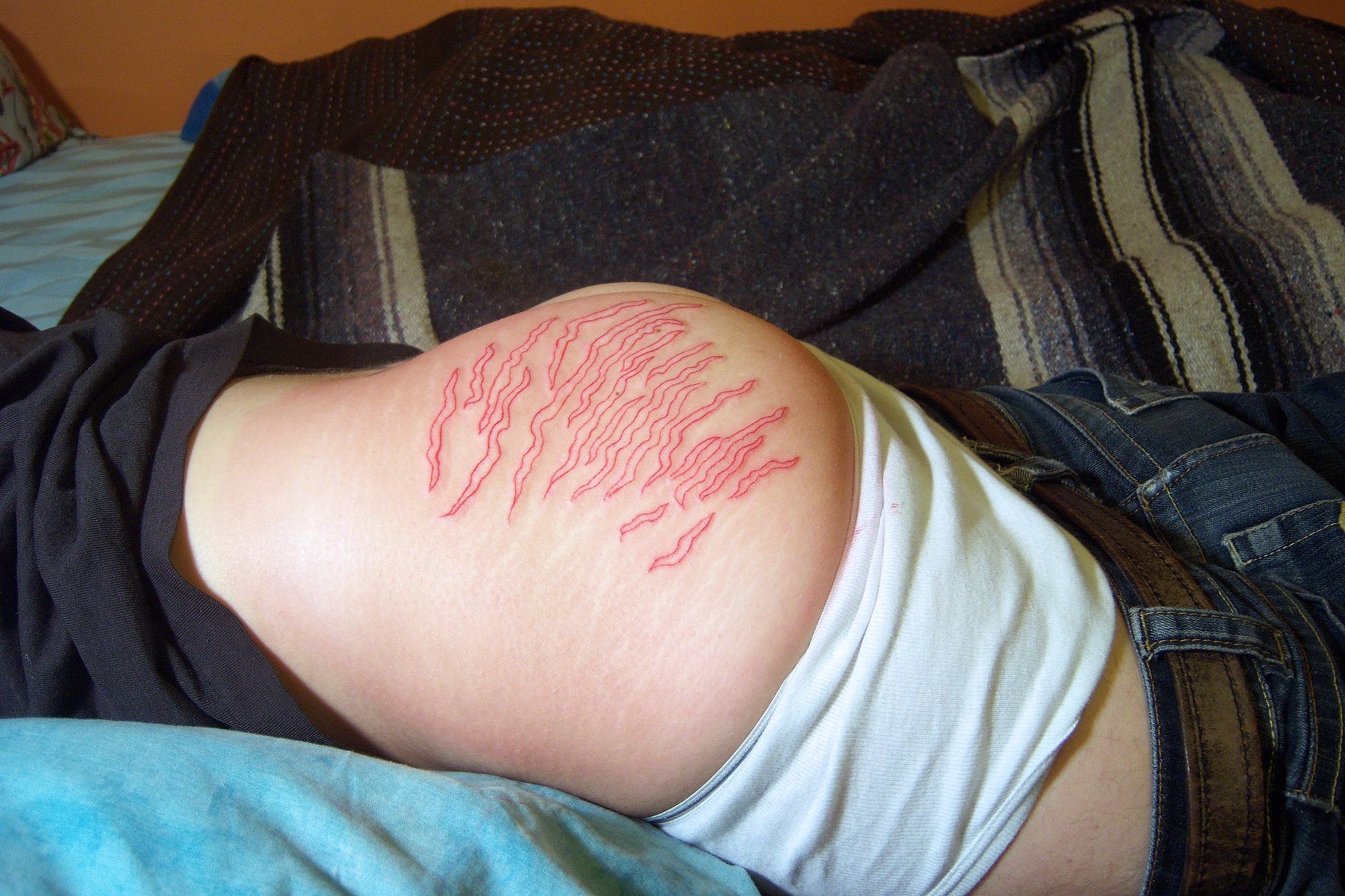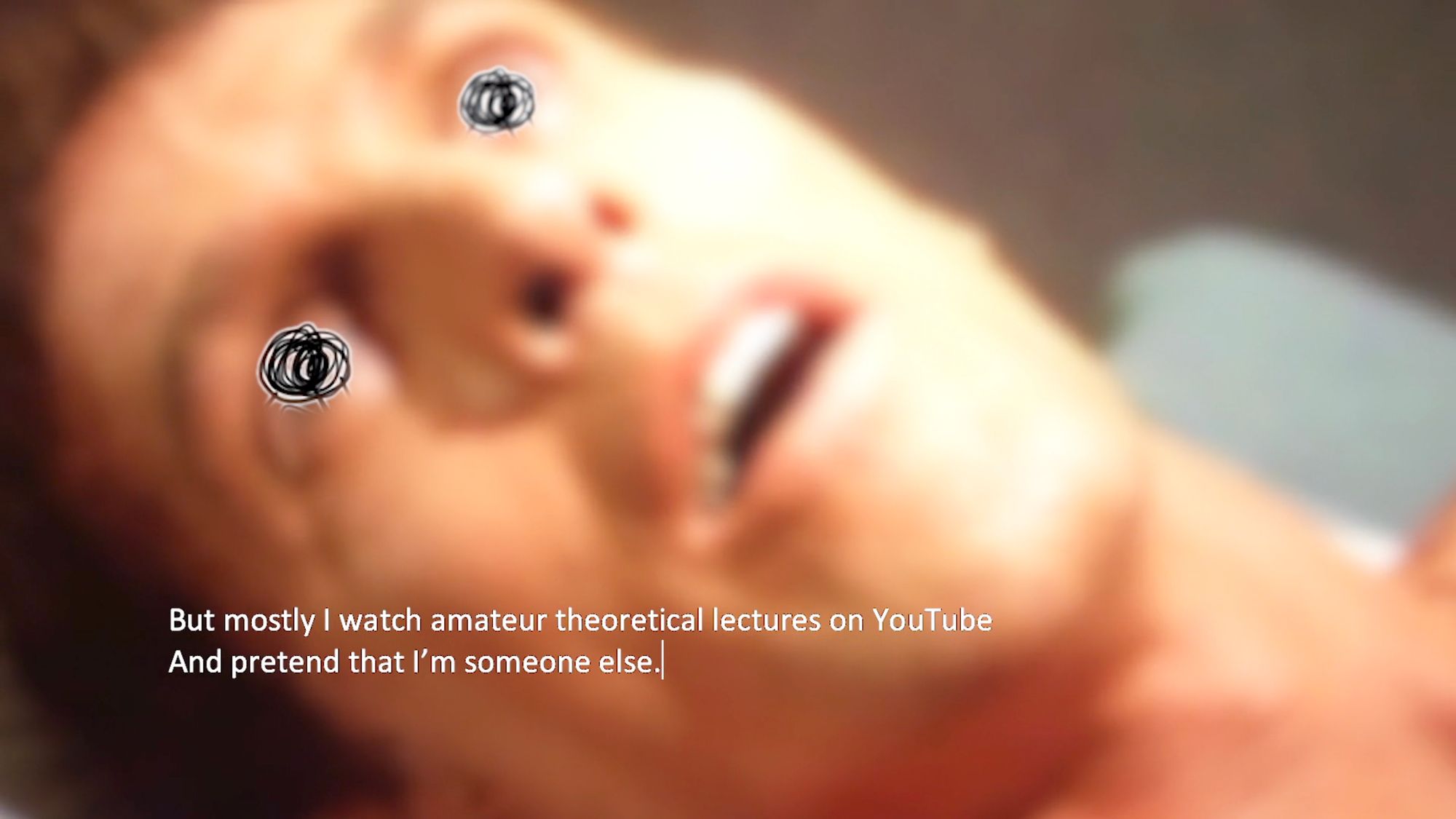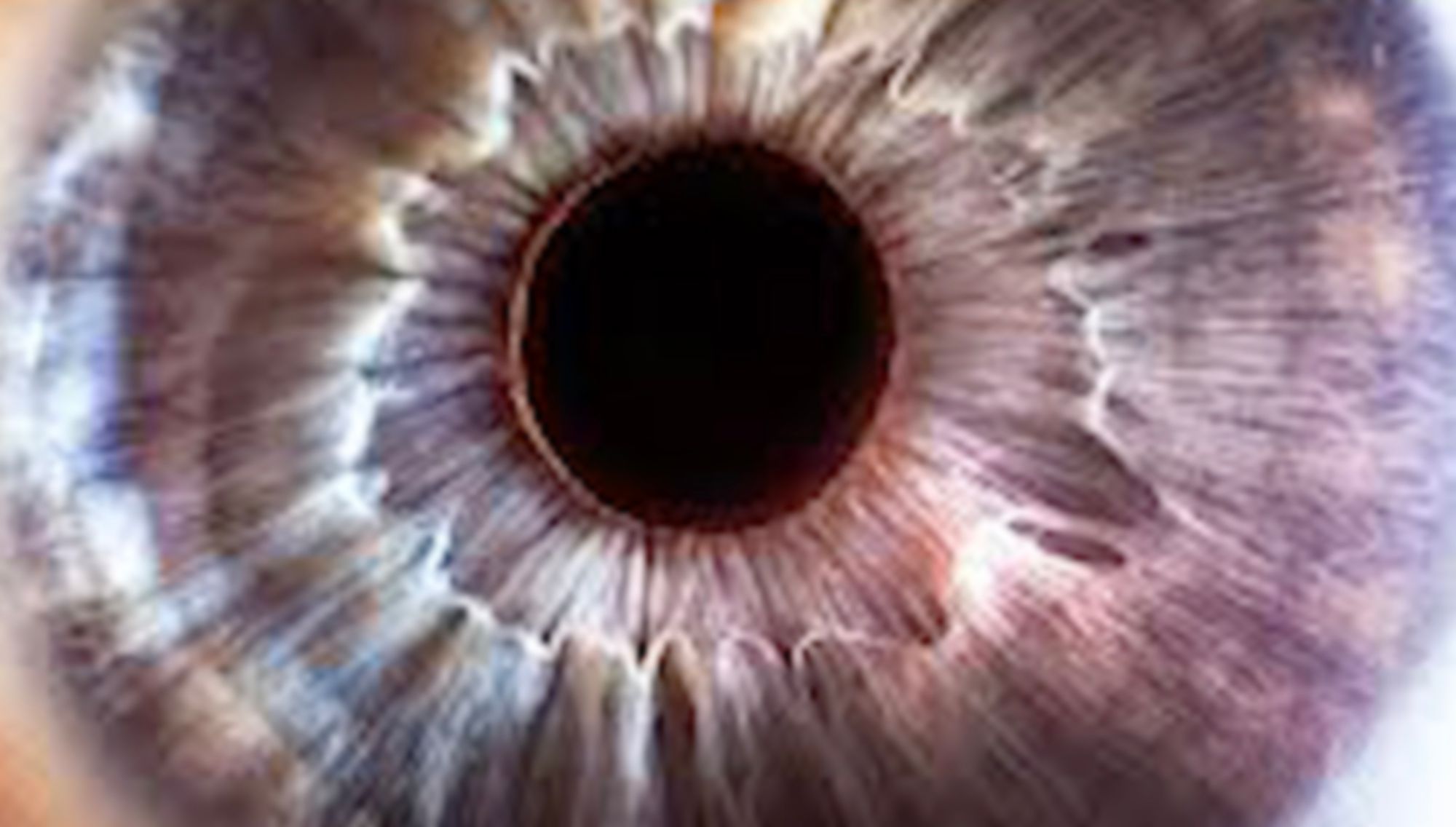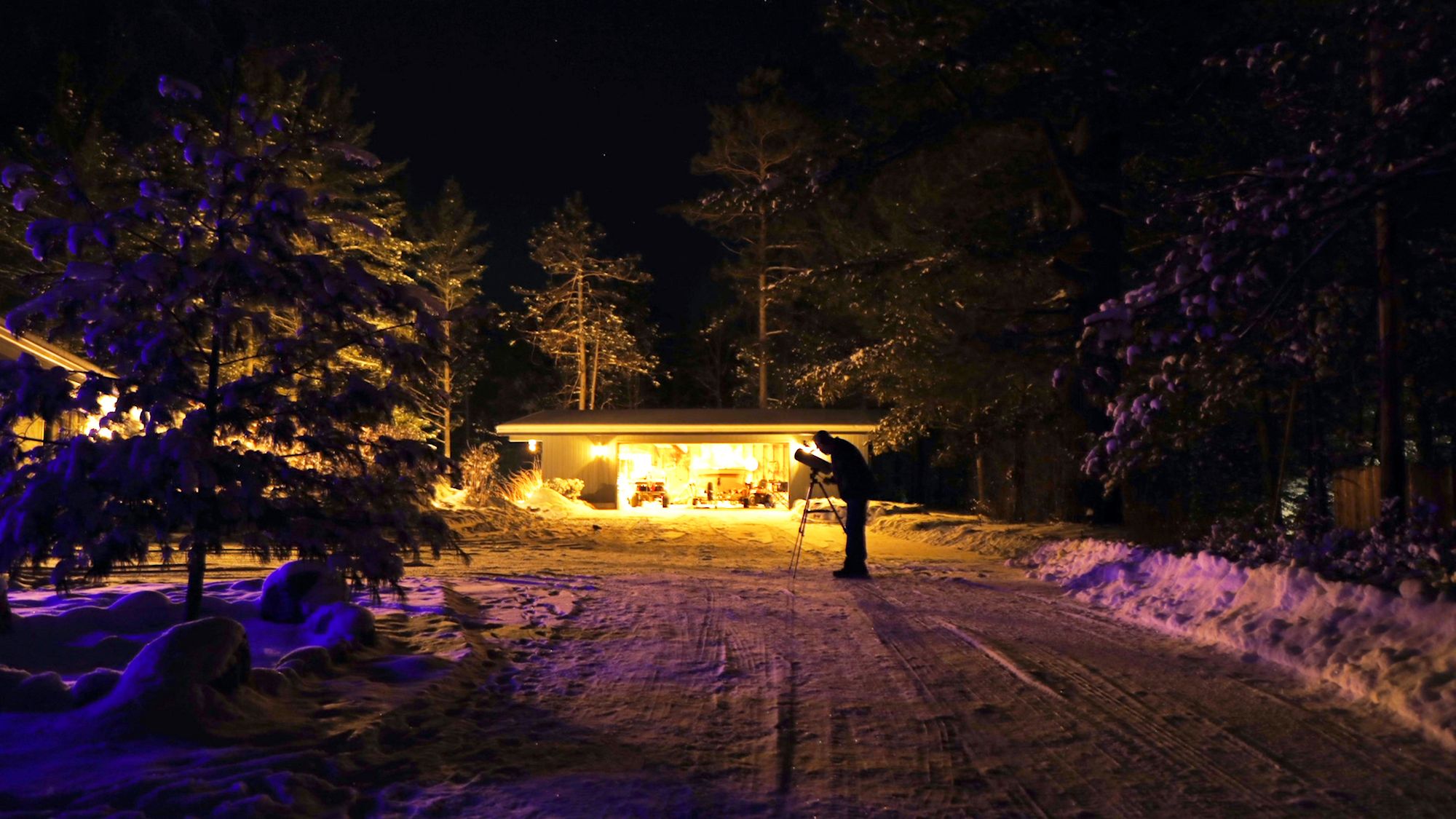The Hole Is a Center
Angelo Madsen Minax, In Flight, Vietnam, 1968 (2022), 48 x 36 in., inkjet print.
Angelo Madsen Minax and I first met about fifteen years ago, around the time he made Riot Acts (2010), a tender and nuanced documentary about trans and gender-nonconforming musicians’ lives, both on and off-stage. Soon after, I saw some of the photographs from his Cuts for Luck, Scars for Freedom project (2010–2012)—for which he collaborated with people to tattoo their own stretch marks. These direct and up-close photographs struck me for how they tenderly and allusively recorded such intimate bodily exchanges. Since then, he has continued to work fearlessly across genres and media—from documentary and experimental film to installation and sculptural practices—to tackle head-on the push and pull of being with others, and the wounds that can result from longing for connection. In 2021 his critically acclaimed autoethnographic feature film North by Current was aired nationally in the United States by PBS, and in 2022 he received a Guggenheim Fellowship.
Minax often fictionalizes his own past experiences to question boundaries, bonds, and ecstatic possibilities. On the occasion of Minax’s exhibition “A Crisis of Human Contact”—which opened at the De La Warr Pavilion in the UK in 2023, not long after he completed a residency at Pioneer Works—we organized this conversation to explore the themes that run through his films, photographs, and sculptures, old and new.
I'd like to start not with your recent film and video work—which you've become known for—but at a slightly earlier moment, when you made a series of photographs of tattoos that you offered in your apartment. In looking to that moment, they help clarify the terms of your later videos for me. After all, this practice of tattooing was both about the inside and outside of the body at the same time.
I had just apprenticed with a tattooist in California, Idexa Stern, who was also a lover, a friend, and a part of this extended queer fairy community in the Bay Area. One of the things I walked away with from that experience was the idea that a tattooist's job was really to work with what the body was already offering. And it was the first time I'd heard that—to let the skin tell you how the tattoo should be shaped or formed rather than the idea that you put the tattoo on the skin. Idexa believed that the body dictates what the mark is and where it should go, and I really loved that approach. This filtered right into the idea I had, which was to start tattooing stretch marks on people. I put out this call to friends, to essentially reify what’s already there—and to reclaim what we are socialized to feel shame about.
Was that one of the first times you worked so intimately with other people?
I had been doing music projects and bands for a long time. But in terms of a collaboration that had less of an intended outcome and more of a loose idea of how it was going to look or feel, yeah. But these were super punk, DIY. I had trained with a tattooist, but I was definitely not a good tattooist. I was chicken scratching on my close friends who were comfortable with a symbolic, albeit maybe kind of crappy tattoo. I was drawn to how the skin is malleable, where the inside meets the outside, and how we can gesture to previous bodies and that history... there are ways that a body is always marked by histories, whether we acknowledge them or not. I just wanted to point them out.

Cuts for Luck, Scars for Freedom (Jakob), 2012.
It changes the nature of the tattoo to actually draw out the inside of the flesh in a different way. Conventionally, tattoos are thought of as being placed on the surface rather than in the flesh. This early work of yours seems to me very much part of a theme that I see throughout your work—this idea of the inside and the outside being in a dynamic exchange. But the other thing is that your work has become very, very collaborative and you've worked with people both in fictional and autobiographical settings who become folded into and are very much agents within your films. And that, in many ways, is also the breaking down of boundaries. Would you call it collaborative? Is that a useful word for you?
I think it’s collaborative for sure, but it's also very curated and calculated and dictated by me. I'm still pulling all the strings and making a lot of specific choices.
It's more like you enlist the intimacy of other people.
Exactly. That's a great way to put it. I need some energy to ping off of, and I prefer it if it's more than two nodes of information. If there's only two nodes, you have a dichotomy or a binary. But if there's multiple nodes, you can ping. And I think recruiting others to co-move through these ideas creates the thing off which I can ping. And hopefully they have a ping too. And it's a generative pinging for everyone. I don't think I've ever said the word “ping” so many times in one breath.
I think one of the things I love about working with people in that way is that you have to create with what's been given to you. In a narrative film, for example, you are constructing the exact environment you want, whereas when you're working with other people in a more process-oriented way, you're forced to confront specific obstructions in what they're offering. And I really prefer to work from sets of obstacles. I think that's really generative for me.
It's interesting because even just the structure of some of your recent films—I'm thinking of The Eddies (2018) and Bigger on the Inside (2022)—which take the general form of a dialogue or exchange between two people, but quickly move orthogonally by adding in other contexts, other images. It quickly spins out into all of these other elements. And again, that structure of the pair opening up to complexity and also being reflected in and jarring those boundaries seems, to me, a big theme in a lot of your work, especially the video work.
Pushing against those boundaries is how I make meaning. When things start compounding, I ask how does each piece of information get reinterpreted through the new image or the new sentence or the new piece of information that followed it? I love the porousness of that space and interrogating it because there’s nothing there. And everything is there. You can’t put your finger on it. You can’t point to it in the same way you can point to the earlier work. I mean, I think to call it liminal is almost simplifying it, but that line between inside and outside is in a constant state of malleability and flux. I love how many different directions it can go. You can go abject with it, you can go spiritual with it, you can go erotic with it. There’s so much potential in that little thing, which is also enormous to explore.
Again, I’m thinking of what you say in your mini lecture nested within Bigger on the Inside in which you talk about the lover, the beloved, and the need.
The thing I love about the mini lecture is that most people don’t know it’s me. They don’t know me. I think a lot of people just assume it’s a half-baked YouTube thing.
But that's also something that you encourage.
Absolutely.
Using informal or amateur knowledge is the way some people survive. It can be a way to make our way through the world, through institutions or bodies of knowledge or discourses that don't support or recognize us. Amateurism becomes the one way to resist that. But you really foreground this idea of ad hoc knowledge.
I love the idiosyncratic, and I love drawing out a character. I'm just wrapping up post-production on a documentary commission, called One Night At Babes, that’s structurally very conventional, but it's really pulling out specific types of knowledge and experiences people have had. And they’re presented in a very colloquial way. They don't have to be built out in a formal framework or even a framework that is recognizable to the art world. There’s something I love about being an amateur. It’s sort of close to being a wingnut.
Sometimes people use the word knowledge interchangeably with facts, or science, or some sort of certainty, but knowledge is more than that. It is both embodied and perspectival. And I think that's one of the things I see you always returning to: that idea that knowledge is positional and that one person's knowledge is not necessarily another's, even if it’s the same type of experience, the same type of body, the same site or place. Again, that’s part of this unsettled inside-outside dynamic. Your films and installations clearly both come from you and your experience, but also have something more to say because of that experience—they have moments in which they take on the mode of a teacher.

Bigger on the Inside, Impregnation Still.

Bigger on the Inside, Eyeball Still.

Bigger on the Inside, Telescope Still.
It encourages a viewer to question the nature of truth, which is important to me because my work stems from documentary and nonfiction and those are not necessarily synonymous with truth. For me those moments of direct address or didactic instruction are really about calling my own knowledge and perspective into question, in a way that makes it blatant to people that they should be asking themselves questions while they're watching my work. "Yes, question everything I say," and, "Yes, why would you ever think that I'm ‘good’ because I'm speaking to you?"
My experience of your works is that what I thought I knew at first becomes both deeper and more uncertain as you lay out a map of alternative realities—maybe that’s too strong a word. How about “positions?” But this temporal charting of expanded possibilities is also spatial, in installation and sculpture. If your films question temporality and authority, how does that operate in space in your sculptural installations, when an unruly spectator could go anywhere?
I ask a lot less of an audience in those situations because film is so deeply enculturated and woven into our day-to-day lives that people are conditioned to experience it a certain way. Spatially I feel like I have more freedom and do less handholding. But at the same time, my installations have lots of multiples and texts—things that feel blatantly film-adjacent to me. But they’re also motivated by a linear experience. That conundrum is its own interesting hole to go down, in terms of thinking about all of the ways in which the work attempts to resist the linearity that it is inherently bound to, and that our lives are bound to.
My exhibition “A Crisis of Human Contact,” at the De La Warr Pavilion, felt a little bit like one big film installation. You could drop into it at any point and move to the next thing and the work was still conversational. When you walked in there was a short video I made with two people that I've been collaborating with in various ways for 20 years now. It takes place during the daytime in a dungeon space, with light coming through the windows and chains draped over the walls. And then in the exhibition the chain piece was on the floor. So I was thinking about how those works could be in conversation without having to be experienced linearly.
So much of your work is about questions of space: what are the interfaces between the inside and outside? In what ways can we fill negative space? Were there any moments in the installation that became particularly energized for you when thinking about how to lead people through this Cartesian box?
I'm pretty into science fiction, so the way I thought about that gallery space was like warp speed travel in Star Trek. Converting time to space, basically. You take the line, which is a piece of paper, fold the piece of paper on itself, and stick the pencil through. If you take a piece like Vietnam, 1968 (2022) and you stick the pencil through it, on the other side is In Flight, Vietnam 1968 (2022).
The first part of the duet is a photograph of me holding a photograph that my dad took out of an Air Force fighter jet that was flying over Vietnam in 1968. It is a small, 4 x 6 snapshot looking out the window with lots of clouds, and you can see part of the wing of the plane and you can see a slight bit of metal interior and the roundness of the window. I'm holding that image up with my hand in the night sky. There is a leaning tree in the periphery and I’m trying to trace the lean of that tree with my arm, so I can put the photograph back where it belongs, in the sky. Where can I position it in a cosmology?
The second part, called In Flight, Vietnam, 1968 (2022) takes this layered, self-referential aspect further. I photographed Vietnam, 1968 hanging in a room in front of a green screen. You can see various levels of staging around Vietnam, 1968: a big ring light that circles the work, like a glowing orb circling this photograph that's floating in space; the rigging along the top of the green screen; and all the light stands. It’s all the artifice that would normally be hidden when you're working in a studio. The whole point of a studio is to make that setup disappear. In Flight, Vietnam, 1968 foregrounds the fact that it is impossible to get back to a previous moment. You can't put anything back where it came from.
It’s about all the things we don't see, and the distance between us and that image which, as you say, cannot be put back or that we can't go back to, to use both the spatial and temporal metaphors. But let me ask you about one more work, Both the Wound and the Remedy (2023), that’s particularly resistant to documentation and to photography.
I poured a blob of latex in the center of two relatively small acrylic sheets. There's some texture and depth to the way the latex dried. The sheets hang from C-clamps on the wall, while in front of them a transparency has the words "both the wound and the remedy" printed on it in vinyl, in very small lettering. It’s weighed down by a dangling, lead fishing weight.
Laid directly beneath that center point on the floor rests another 11-by-17 acrylic sheet that also has a latex pour on it, on top of which is the vinyl word "both" spelled out in pretty simple lettering that mimics the text on the wall piece. So there's a very clear eye level line. I’m thinking about refraction or reflection in the same way I'm thinking about it in Vietnam, 1968 and In Flight, Vietnam, 1968—the idea of folding the sheet and coming out the other side. These kinds of works are more directly conversational, and have multiple three-dimensional layers to them and levels of transparency—whether it's tracing paper or other forms of paper vellum, or things that have holes in them or holes on top of holes—in which the inside becomes an outside. Remember the hole is a center, but the hole can't exist without the other stuff around it too.

And just because of the way that piece works in space, it can't be taken in all at once. You’re either looking ahead or looking down, or potentially seeing a reflection. So, its sculptural elements produce a perspectivalism.
Exactly. And I love that the materials I use reference both construction and also BDSM culture—the C-clamps, the hardware, the chains. The lead weights are commonly used for ball weights.
I'm working on a film right now about photographer and performance artist Fakir Musafar and the underground body modification and S&M movements of the late 1970s to the 90s. The film is called A Body to Live In, and it goes down this other deep hole of that cultural moment, of AIDS, and then Fakir’s own dying process. And because I'm so deep in this archive right now, all of his words are juggling around in my brain. But I just listened to one of his interviews this morning, and he very candidly said, "You take the flesh, you take the spirit, you slap them together and then you’ve got a whole person." But what does that mean, a whole person? How do we activate all three and get to the inside from the outside?
As I've been viewing your work and watching some interviews with you, you often say you like to pick at things. Picking is at the surface, but it activates a reaction in the body. It's both a stimulus and an incursion, but it's deliberately local in scale. That seems to me like a very conceptually and corporeally rich metaphor for what you do. Can you talk a bit more about what you mean by that phrase?
I love the concept—and the practice—of dry needling, which is an acupuncture-esque technique where you insert a needle into the muscle tissue to stimulate blood flow and tissue regeneration. It’s like making a small wound on top of an older, larger wound. It actually encourages the older wound to heal. When I'm approaching ideas that are more conceptual or out there, or that deal with potentially troubling content like bestiality, I skirt their shock value by carefully pulling at, and pointing to, the ideas rather than throwing the viewer into them without a net. It's like I'm holding you while you're having these uncomfortable feelings, but I also won’t shelter you from the hardness of it. I think picking is just gentler. I want to be someone who picks at wounds. ♦
Subscribe to Broadcast